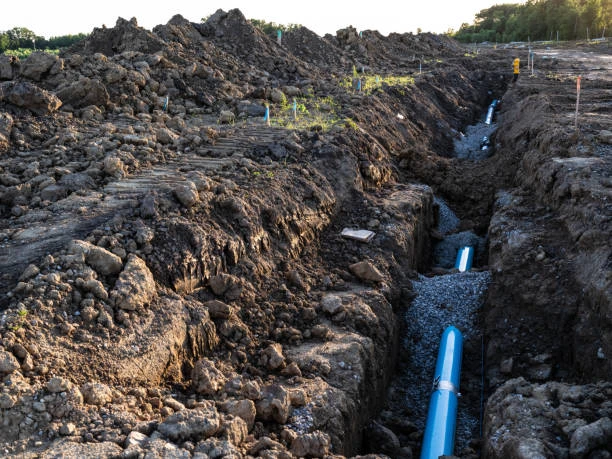In a surprising discovery in Wichita, Kansas, a century-old wooden Water pipe has been unearthed during a routine maintenance project. This rare find has captured the attention of both local residents and historians, shedding light on the history of the city’s water infrastructure and how far the technology of water delivery has come. In this article, we will explore the significance of this wooden water pipe, the role of water pipes in urban infrastructure, and the evolution of water systems in cities like Wichita. We will also discuss the challenges of maintaining aging infrastructure and the importance of ongoing investment in modern water systems to ensure clean, safe water delivery for future generations.

The Discovery of the Century-Old Wooden Water Pipe
The discovery of a wooden water pipe in Wichita came as a shock to local engineers and construction workers who were conducting routine excavation work. The pipe, which dates back more than 100 years, was found beneath the streets of Wichita, where it had been buried for decades.
Upon closer inspection, it was clear that the pipe had been made from a type of wood known for its durability, most likely cedar, which was commonly used in water infrastructure projects during the late 19th and early 20th centuries. While the pipe was not in use at the time of its discovery, its existence offered a rare glimpse into the past, highlighting the ingenuity of early water systems.
Wichita, like many other cities in the United States, relied on wooden pipes for water delivery long before the widespread use of metal, concrete, and plastic piping. These wooden pipes were a crucial part of the infrastructure that helped cities grow and develop during the industrial era.
What the Wooden Pipe Reveals About Early Water Infrastructure
The discovery of this century-old water pipe offers important insights into the early water systems of Wichita and other cities of the time. Wooden pipes were one of the first solutions used to transport water through urban areas, especially in places where metal or clay pipes were not readily available or affordable.
Wooden water pipes were often made from logs that were hollowed out, joined together, and sealed with natural resins to prevent leaks. In some cases, the pipes were reinforced with metal bands to increase their durability. Although they were effective for transporting water in their time, wooden pipes had limitations, including their susceptibility to rot, leaks, and damage from freezing temperatures. As a result, they were gradually replaced by more durable and longer-lasting materials as technology advanced.
Why Were Wooden Pipe Use in Wichita?
The use of wooden pipes in Wichita, and many other cities, can be trace back to the late 1800s and early 1900s, when urbanization and population growth necessitated more efficient water distribution systems. At the time, wooden pipes were a practical choice for a number of reasons:
- Availability of Materials: Wood was an abundant and relatively inexpensive material. In the late 19th and early 20th centuries, local timber was widely available, making it a cost-effective option for building infrastructure.
- Durability: Despite their eventual limitations, wooden pipes were durable enough for the job. Cedar, in particular, was resistant to rot and decay, which made it a popular choice for water pipes.
- Ease of Construction: Wooden pipes were easier to construct than metal or clay pipes. The process of hollowing out logs and shaping them into pipe sections could be do with relatively simple tools, making it more accessible for cities without advance manufacturing capabilities.
- Adaptability: Wooden pipes were easier to repair and maintain in the early stages of urban development. When leaks occurred, they could be quickly patche or replaced, which made them a practical solution for growing cities.
The Evolution of Water Systems in Wichita
The use of wooden pipes in Wichita was part of the broader trend of water infrastructure development that took place across the United States in the late 19th and early 20th centuries. As cities expanded and populations grew, the demand for clean, reliable water increased. Water distribution systems were built to bring water from nearby rivers, lakes, or wells to residential and commercial areas. In the early days, wooden pipes were an essential part of these systems.
However, as technology improved, the limitations of wooden pipes became apparent. Wood, while durable for a time, was prone to rotting, warping, and being damage by pests. In addition, wooden pipes were more prone to leaks, which led to water wastage and inefficiency in the system. As a result, cities like Wichita began replacing their wooden pipes with more modern materials such as cast iron, steel, and later, concrete and PVC.
The transition away from wooden pipes was a gradual process that occurred over several decades. Today, most of Wichita’s water distribution system is compose of more durable materials like ductile iron, which is resistant to corrosion and is much more reliable than wooden pipes. The discovery of the wooden water pipe in Wichita serves as a reminder of the city’s historical development and the technological advances that have made today’s water systems more robust and efficient.
The Role of Water Pipe in Urban Infrastructure
Water pipes are one of the most essential components of urban infrastructure. They are responsible for delivering clean, potable water to homes, businesses, and public facilities. Water pipes also carry wastewater away from homes and businesses, ensuring proper sanitation and hygiene. Without a functioning water pipe system, a city cannot function properly.
The Different Types of Water Pipe
Over the years, a variety of materials have been use to build water pipes. Here are some of the most common materials use in water pipe construction:
- Wooden Pipes: As we’ve discussed, wooden pipes were widely use in the past. Though they are no longer in use in most cities, they played an important role in the development of early water systems.
- Cast Iron Pipes: Cast iron was one of the most popular materials for water pipes in the late 19th and early 20th centuries. Cast iron pipes are strong and durable but are prone to corrosion over time.
- Steel Pipes: Steel pipes are stronger and more resistant to corrosion than cast iron. They were widely use in the mid-20th century, although they have largely been replace by other materials.
- PVC (Polyvinyl Chloride) Pipes: Today, PVC pipes are commonly use for water distribution. They are lightweight, resistant to corrosion, and easy to install. PVC is an ideal material for modern water systems due to its affordability and durability.
- Ductile Iron Pipes: Ductile iron is a more flexible and corrosion-resistant version of cast iron. It is widely use in modern water systems, particularly for large-scale municipal projects.
Each material has its advantages and disadvantages, and the choice of material depends on factors such as cost, climate, and the specific needs of the water system.
Challenges of Maintaining Aging Water Infrastructure
One of the major challenges facing cities like Wichita is the maintenance of aging water infrastructure. As many of the pipes in older systems approach or exceed their expected lifespan, cities must address the risks associated with leaks, bursts, and corrosion.
Aging infrastructure can result in water loss, increased maintenance costs, and disruptions to service. Additionally, older pipes are more susceptible to contamination, which can compromise water quality. For example, lead pipes, which were commonly use in the past, have found to leach lead into drinking water, posing serious health risks.
To address these issues, cities must invest in upgrading their water systems. This includes replacing old pipes with more durable materials, using modern technologies for leak detection and monitoring, and adopting water conservation practices to ensure a sustainable water supply for future generations.
Wichita’s Efforts to Upgrade Its Water Infrastructure
Wichita, like many other cities, is actively working to improve its water infrastructure. The city has made significant investments in replacing aging pipes, modernizing water treatment facilities, and upgrading its distribution system. This is essential to ensure that the city can continue to meet the needs of its growing population while maintaining the reliability and safety of its water supply.
Ongoing Water System Improvements
The city’s water department regularly conducts assessments of its water infrastructure to identify areas that need improvement. This includes monitoring the condition of existing pipes, identifying areas of high leakage, and replacing old or damaged pipes with newer materials. The goal is to create a more efficient and reliable water distribution system that will serve the city for years to come.
In addition to replacing aging pipes, Wichita is also investing in water conservation initiatives, such as promoting the use of low-flow fixtures and encouraging residents to reduce water usage during times of drought. These efforts help to ensure that the city’s water supply remains sustainable and that resources are use responsibly.
Conclusion
The discovery of a rare, century-old wooden water pipe in Wichita serves as a reminder of the city’s historical development and the importance of maintaining modern water infrastructure. While wooden pipes were once a key component of early water systems, advances in technology have led to more durable and efficient materials for water distribution. As cities like Wichita continue to grow and face challenges related to aging infrastructure, investing in modern water systems will be crucial to ensuring a sustainable and reliable water supply for future generations.
Frequently Asked Questions (FAQ)
1. What caused the water pipe to be make of wood in Wichita?
Wooden pipes were commonly use in the late 19th and early 20th centuries due to the availability of materials, ease of construction, and their durability at the time. They were a practical choice before metal and plastic pipes became widely available.
2. Are wooden water pipes still in use today?
No, wooden water pipes are no longer use in modern water systems. They have been replace by more durable materials like ductile iron, PVC, and steel.
3. Why did wooden pipes eventually get replace?
Wooden pipes were prone to rotting, leaks, and damage from freezing temperatures. As technology improved, more durable and efficient materials like cast iron and PVC became the preferred choices for water distribution


















